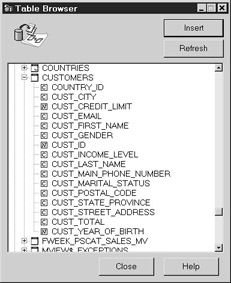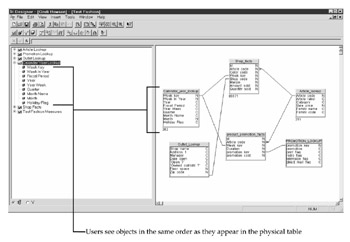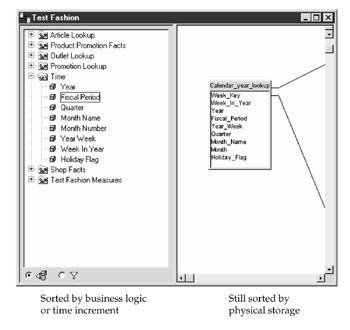Object Ordering
|
| < Day Day Up > |
|
If you use the Designer Wizard to build your universe, objects are added either in alphabetical order or in the order they are stored in the physical tables. In the database.sbo file, there is a parameter ColSort. The default for Oracle is ColSort=3, which means that columns in tables appear alphabetically in the table browser (shown in Figure 8-3 on the left) and therefore are alphabetical in the universe the wizard builds. If you change the ColSort=13, then objects are sorted according to their physical order in the table (shown on the right). This is a much better sort order because join keys then appear at the top of the table browser, rather than being intermingled throughout the list.

Figure 8-3: The parameter Colsort=3 sorts columns alphabetically (left), whereas the parameter Colsort=13 sorts columns by the order in which they exist in the physical table (right).
In Informix, the default for ColSort is 2,3,7, causing the columns to be sorted by type. This may be okay as well, since most join keys will be numeric. In ODBC, the default and only possible value is ColSort=3 (physical).
The order of the columns in the table browser and the order of the objects that users see are only partially related; if your objects are automatically added to your universe when you insert a table (use the pull-down menus Tools | Options, select the Database tab and check Create default classes and objects from tables) or if you build your universe with the Quick Design Wizard, then the order of the tables and fields in the table browser will match the order of the classes and objects in the Universe pane. However, if you do not like this predetermined order, you can manually reorder the objects by dragging and dropping them. Notice in the following screen from the Test Fashion universe we created in Chapter 6 that objects in the Calendar Year Lookup class are in the same order as in the physical table CALENDAR_YEAR_LOOKUP:

This order is really not logical from a business viewpoint; Week is a smaller increment than Year, but then Month appears after Quarter. However, alphabetical is not logical either. Therefore, you must manually re-sort the objects into incremental order by dragging and dropping. The following screen shows how you want the sort order to follow time increments, running from year to month to week. As explained in Chapter 11, for multi- dimensional analysis, the larger increment or grouping should always appear at the top, the most detailed at the bottom. This sort order facilitates drill down.

|
| < Day Day Up > |
|
EAN: 2147483647
Pages: 206
- Chapter V Consumer Complaint Behavior in the Online Environment
- Chapter VI Web Site Quality and Usability in E-Commerce
- Chapter X Converting Browsers to Buyers: Key Considerations in Designing Business-to-Consumer Web Sites
- Chapter XI User Satisfaction with Web Portals: An Empirical Study
- Chapter XV Customer Trust in Online Commerce